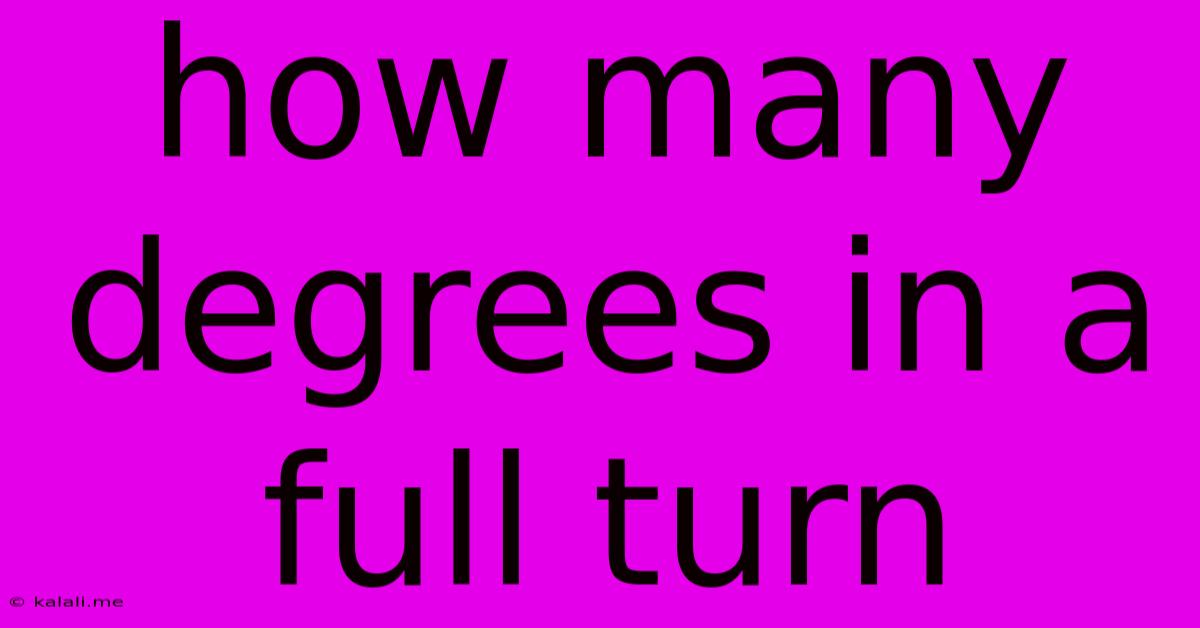How Many Degrees In A Full Turn
Kalali
May 21, 2025 · 3 min read

Table of Contents
How Many Degrees in a Full Turn? A Comprehensive Guide
Meta Description: Discover the answer to the fundamental question: how many degrees are there in a full turn? This guide explores the concept of angles, circles, and degrees, providing a clear and comprehensive understanding. We'll also delve into related concepts to solidify your knowledge.
A full turn, or a complete rotation, represents a fundamental concept in geometry and mathematics. Understanding how many degrees constitute a full turn is crucial for various applications, from basic geometry to advanced calculations in fields like engineering and physics. So, how many degrees are there in a full turn? The answer is 360 degrees.
Understanding Angles and Degrees
Before diving into the specifics of a full turn, let's briefly review the concept of angles and degrees. An angle is formed by two rays that share a common endpoint, called the vertex. Degrees are a unit of measurement used to quantify the size of an angle. A circle is divided into 360 equal parts, each representing one degree (1°).
Why 360 Degrees?
The use of 360 degrees in a circle is a historical convention, likely stemming from the Babylonian civilization. The Babylonians used a sexagesimal (base-60) number system, and 360 is highly divisible by many numbers (2, 3, 4, 5, 6, 8, 9, 10, 12, 15, 18, 20, 24, 30, 36, 40, 45, 60, 72, 90, 120, 180). This divisibility made it convenient for various calculations and subdivisions of the circle.
Other Units of Angular Measurement
While degrees are the most commonly used unit, other units exist to measure angles:
- Radians: Radians are another common unit, particularly in advanced mathematics and physics. One radian is the angle subtended at the center of a circle by an arc equal in length to the radius of the circle. A full turn is equivalent to 2π radians.
- Gradians (or grads): A gradian is another unit where a full circle is divided into 400 gradians. This system is less common than degrees and radians.
Applications of Understanding Full Turns
The concept of 360 degrees in a full turn has wide-ranging applications:
- Navigation: Understanding angles and degrees is crucial in navigation, particularly when using compass directions and determining bearings.
- Engineering: Engineers use angles and degrees extensively in design and construction, ensuring precise alignment and measurements.
- Computer Graphics: Computer graphics rely heavily on angles and rotations to manipulate images and create animations.
- Astronomy: Astronomers use angular measurements to describe the positions and movements of celestial bodies.
Beyond the Basics: Exploring Related Concepts
Understanding a full turn (360 degrees) opens the door to exploring further geometric concepts like:
- Arc Length: The length of a section of the circumference of a circle.
- Sector Area: The area of a portion of a circle enclosed by two radii and an arc.
- Trigonometry: The study of relationships between angles and sides of triangles, heavily reliant on angular measurement.
In conclusion, while the answer to "How many degrees in a full turn?" is simply 360 degrees, understanding this fundamental concept lays the groundwork for a deeper understanding of geometry, mathematics, and its diverse applications across numerous fields. The historical context and alternative units of measurement enrich our comprehension of this core mathematical principle.
Latest Posts
Latest Posts
-
Can You Paint Pressure Treated Wood
May 23, 2025
-
Is Ash Wednesday A Holy Day Of Obligation
May 23, 2025
-
How To Get Rid Of Mold On Wood
May 23, 2025
-
Bookmarklet That Expands All Comments And Replies In Facebook Posts
May 23, 2025
-
Do Catholics Believe In The Rapture
May 23, 2025
Related Post
Thank you for visiting our website which covers about How Many Degrees In A Full Turn . We hope the information provided has been useful to you. Feel free to contact us if you have any questions or need further assistance. See you next time and don't miss to bookmark.